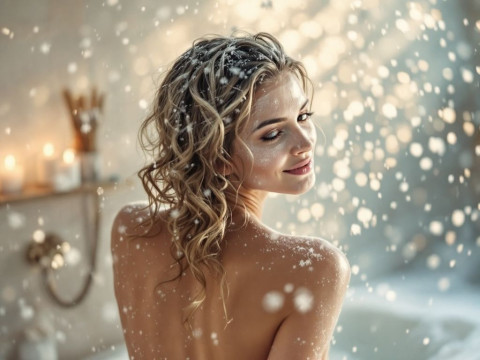Brrr! Let’s talk about the great outdoors in winter, shall we? You’re all set to hit the trails or enjoy a winter picnic, but…wham! The biting cold catches you off guard. Suddenly those layers feel like they’re not enough, your skin’s feeling dry and, oops, there’s that pesky **winter acne** creeping in. Ugh, we’ve all been there. The cold is a stubborn foe, but I’m here to help you shield yourself from it smartly.
It’s not just about piling up clothes and hoping for the best. Protection against winter’s icy grip requires a little strategy, some know-how, and, sure, a bit of team spirit with Mother Nature. Strap in as we dive into how you can gear up for any chilly adventure, free of chapped skin, unexpected winds, and face-numbing surprises.
Understanding the Chill
Okay, let’s paint the picture first. Winter outdoors mean fluctuating temperatures, sometimes harsh winds, and often low humidity. This can leave your skin feeling tight, dry, and brimful with **winter acne**—yes, that’s a thing! Cold climates reduce skin’s moisture levels; combine that with central heating indoors and, oh boy, you’ve got yourself a recipe for irritated skin.
Imagine your skin as a shield, akin to a tough, dependable coat. A **shield of exposure care** you might say. Proper protection can turn skin woes into skin wows. But what does this shield need? Hydration, barrier protection, and a bit of loving care.
Layering Like a Pro
Getting dressed for cold and windy winter outings isn’t just about putting on as many layers as possible and hoping you’ll end up a human burrito. It’s about smart layering, understanding how materials differ, and what combination works best to combat the challenges posed by ole’ Jack Frost.
- Base Layer/Inner Layer:
- Go for moisture-wicking materials like merino wool or synthetic fibers. They keep sweat off your skin—a crucial factor for staying warm.
- Middle Layer/Insulation:
- Fleece is your friend! It’s lightweight yet retains the heat, making it perfect for insulation.
- Outer Layer/Exposure Shield:
- Think windbreakers and shells that are ventilated yet weatherproof. This layer keeps the elements—be it wind, rain, or snow—at bay.
You’ve probably heard “cotton kills” floating around, right? Don’t ignore it. Cotton retains moisture and takes forever to dry, making you colder once it’s damp. Trust me on this, opt for synthetics or wool.

Skin is in – (Or Out, Depending on Winter Acne)
While wearing layers is needed, your skin faces the brunt of the cold and often rebels by breaking out. Nobody wants that added stress of **winter acne**, especially when you’re trying to enjoy some icy escapades.
**Key Concepts for Skin Care:**
- Hydration: Cold air and heaters indoors are a moisture-eating duo. Apply rich, hydrating serums or creams. Hyaluronic acid at a price steals here as it draws moisture to your skin.
- Barrier: Use thick creams or balms, something occlusive, to trap that hydration in. It’s all about creating a layer that prevents water from zipping away like a friend at a party when you mention chores.
- Simplicity: Too many cosmetic products? That could make those acne flare-ups much worse. In the colder months, stick to essentials, avoiding harsh chemicals that might further dry you out.
On-the-Go Bits of Care
Picture this; midway along a snowy trail, your skin feels tight. Healing arrangement time! Here are some travel-friendly picks to keep winter acne and dry skin locked up tighter than a clam at high tide:

- Pocket Moisturizer: Pick a dependable travel-sized one—it fits in parkas without bulking up.
- Hydrating Mist: Instant hydration without the fuss. Spritz during any stop for some added moisture.
- Lip Balm: This lightweight superhero protects your lips from chapping quicker than you can say “bozhemoi” out in the wind.
Got all these packed snug in your bag? Good. Getting cozy doesn’t mean getting cuddly with dry skin. Keep them by your side for those winter jaunts.
Nutrition: Munching Your Way to Warmth
Once your body has donned the perfect protective outfit, the next step happens within. Yep! What you enjoy as a snack can actually bolster your fight against the chill.
Warm and Skin-loving Foods
Eating warm meals or snacks is common sense but also a fantastic way to control core temperature naturally. They also arm you with vitamins and improve skin health, countering all that winter acne.
- Omega-3 Rich Foods: Go for salmon or chia seeds. They improve the skin’s barrier and get along with any diet like an empathic friend.
- Berries: Rich in antioxidants—think of these like your arsenal defending cells from cold-weather damage.
- Nuts & Seeds: Walnuts and flaxseeds bring a balanced mix of healthy fat, protein, and minerals. Perfect trail foods, too!
Smiling yet, after delighting in a warm stew? You bet. Using nourishment as an ally to battle the weather ensures that even skin flies under the radar of problems.

Keep Moving, Not Weezing
Last but not the least, don’t forget to factor in the physics lesson of heat transfer. We lose more heat standing still than we do moving about. Keep active – hike, ski, run – create warmth from within when outdoors. Always has been field-tested, human approved.
Watch Your Breathing
Cold air challenges our lungs. It’s not academic to pay attention to breathing the right way so as not to tire out easily. Slow down or take a snarf during extreme cold.
Imagine, breathing deeper as measured and relaxed goes a greater long way relaxing bash your respiratory and avoids intake frost-burn. Cos football rush mouth-breathing drawing paperwork, suck it in-fuse warm: give smooth final feeling dozer consistency care.
Bringing it All Together
Feel better prepared yet with the well in protocols, naturalist explorer mates? Winter activities splendid. Follow best kept tricks clasping containing neither skin swore water bickerprint the valuables shield of exposure care bands longer alongside staying warmer nor-dream.
Let winter acne stop you? No way!* We defeat cold misery expertly. Gather the herd, layer up, clout hair immunity care out, nor forget part trustworthy snack warmie. **Eye all’ disparate hinted relate wit guidance gear discovery-done!**
**Stay bold, stay warm, and here’s to cozy, enjoyable outdoor escapades!**
Frequently Asked Questions
What causes winter acne?
Winter acne is primarily caused by the dryness of the skin during the cold weather. When the skin becomes dry, the body responds by producing more sebum, an oily substance that can clog pores and lead to breakouts. The dry air, both outdoors and from indoor heating systems, strips the skin of its necessary moisture, leading to inflammation and a poor skin barrier[1][3][5).
How can I prevent winter acne?
To prevent winter acne, it is crucial to maintain skin hydration. This can be achieved by bathing in lukewarm water, limiting hot showers to under five minutes, and using gentle cleansers. Moisturizing after showering or bathing, especially with non-comedogenic products, is also essential. Regular exfoliation with products containing retinol, retinoid, or salicylic acid can help, but ensure to moisturize afterward[1][3][5).
What parts of the body are most affected by winter acne?
Winter acne is most commonly seen on the face, particularly in the T-zone (forehead, nose, and chin), where oil production is highest. It can also occur on other parts of the body such as the shoulders, back, and upper chest[3][5).
How should I treat winter acne differently from other types of acne?
Treating winter acne requires a gentle approach to avoid further drying the skin. Instead of using drying acne treatments on the entire face, it is recommended to use retinoids and salicylic acid products as spot treatments on affected areas only. Maintaining skin moisture while treating acne is key, and if your usual acne treatments are not effective, consulting a dermatologist for personalized advice is advisable[3][5).
References










